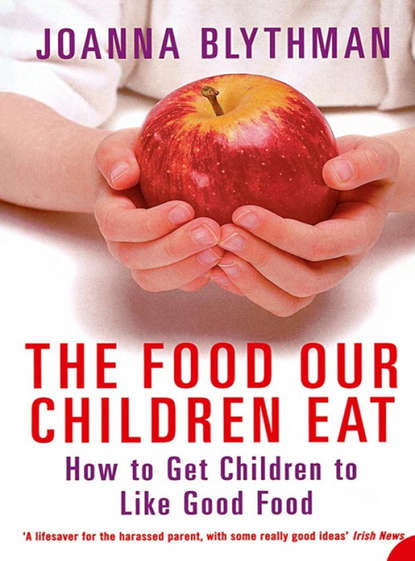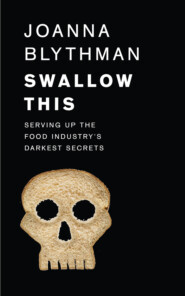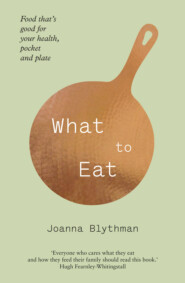По всем вопросам обращайтесь на: info@litportal.ru
(©) 2003-2024.
✖
The Food Our Children Eat: How to Get Children to Like Good Food
Настройки чтения
Размер шрифта
Высота строк
Поля
The good news is that the climate is gradually changing – if only because some restaurants are enlightened enough to recognise that today’s child diners could be tomorrow’s clientele. Some fashionable and very ‘grown-up’ city establishments even become child-friendly zones at weekends, making positive efforts to attract families. Few restaurants fail to provide a high chair (especially if parents ask for one when booking) and many pubs that serve food no longer ban children.
But nevertheless, parents who would like to introduce their children to decent restaurant food from an early age still cannot count on a warm reception, and may fear a negative reaction based on past experience. However well behaved they think their child might be in a restaurant, few parents find it relaxing to be in an environment where they worry that staff eyebrows may be raised and fellow diners may ‘tut’ at the first sign of any restlessness or a querulous voice. So rather than run the risk of embarrassment and assume the stressful responsibility for seeing that the child behaves impeccably, many parents opt out and either don’t eat in these establishments themselves or leave the children at home when they do, thus limiting their children’s food experience.
But is this a problem? Aren’t there plenty of less serious but perfectly acceptable ‘child-friendly’ restaurants at the cheaper end of the market which welcome children with open arms and cater for their every need until they matriculate in the world of adult dining?
You know the formula. They are cheap and approachable chain eateries. If they are out of town, there will be lots of free parking conveniently outside. If you are on foot, it can seem that there is one on every accessible high-street corner or in every food court. They are coming down with trolley parks, high chairs, feeder cups, bottle warmers, microwaves to reheat baby food, nappy-changing facilities … every conceivable bit of kit that adults with children might need. Bustling and noisy, they enable you to eat anonymously without feeling that the eyes of all staff and diners are on you.
And let’s not forget that added incentive which any child will adore. Every day in these restaurants is like Christmas Day because you get a present to take away. We are not just talking about the usual giveaways, such as paper hats, balloons and badges which advertise the restaurant’s existence and link it to cuddly characters designed to appeal to children. We are talking ‘collectables’, a covetable free toy which encourages loyalty (and repeat visits) in order to complete the set. That’s a strong pull for young consumers.
It sounds so perfect for both child and parent … until you get to the food. The heart of the ‘child-friendly’ repertoire? Something fried with chips or something starchy. There’s burger and chips, Kiev and chips, fishy shapes and chips and sausage and chips, all slathered with copious quantities of sweet and salty brown or tomato sauce.
Vegetarian leanings? Try a bean burger, fried veggie rissoles, mini-pizza or refined white baguette with garlic butter. Want to avoid chips? Try fried hash browns or deep-crumb crunchy croquettes for a change.
Feeling thirsty at the thought of that little lot? Why not try an attractively priced whole-meal package, with its ‘free’ fizzy or diluted ‘contains-no-real-anything’ drink thrown in for added value?
So what you get when you step across the threshold of your average ‘child-friendly’ restaurant is a depressingly limited range of the ubiquitous children’s processed foods with a few stodgy snacks and fillers thrown in. It revolves around established ‘kiddie favourites’, formula food that children see all around them. Food that is predictable and ubiquitous. Food that does nothing to extend their horizons. Food that poses no new challenge whatsoever.
Most parents recognise that the food in such establishments is not that great – downright unhealthy even – but, under pressure to find a place that makes it easy to eat out with our children, we convince ourselves that it doesn’t really matter.
After all, children don’t live on restaurant food. Yes, we know that it is full of fat and sugar and heavily processed. As adults, we suspect that the raw materials are not exactly the finest around but, once in a while, what’s the problem? The food is affordable and even though there may be little or nothing we ourselves want to eat, these restaurants are convenient and children seem to like them and see visiting them as a treat.
But are they really such a treat for children? They may say they like eating out in this sort of place, even plead to be taken there, but we need to meet this almost inevitable positive response with a large element of scepticism. For many children, such establishments cannot help being anything but a treat simply because they are the only restaurants to which they are ever taken. Eating out – wherever it is and in whatever circumstances – is always going to be more exciting for a child than just another meal at home.
If we examine what the children actually eat when they visit these restaurants, their enthusiasm for the food may be illusory. A significant part of the meal may end up uneaten because the anticipation is more fulfilling than the reality. The food element may often be ignored in favour of more rewarding diversions, such as playing with the free toy, making endless trips to the toilet, playing in the ‘kiddie playpark’ outside, or watching the toddler at the next booth who has got his head stuck under the table.
We need to address not just the limitations of children’s experience in such restaurants but also the potential breadth of experience on which they are missing out. If this is the only kind of restaurant that children visit, they are getting no taste for the fascinating world of food that lies beyond their own homes. They are deprived of the opportunity of being seduced into trying something new just because it sounds, looks and smells fantastic – something different which extends their domestic food horizons.
When they are taken only to busy, fast-food outlets, they are also isolated from the stimulating sociability of sitting in a restaurant and the chance to enjoy the slower ritual which surrounds the delightful process of eating. Like keen readers stuck for ever on the same formula-book series, they are being denied the chance to discover something initially more demanding but ultimately much more fulfilling.
In fact, confining children only to formula ‘child-friendly’ restaurants is a huge missed opportunity. Handled well, most children can rise to the challenge of eating in a real restaurant serving real food. Even if a taste of real adult eating out is only a rare treat for a special occasion, it can nevertheless be one of the most effective ways of widening children’s food horizons and combating the ‘tunnel effect’ described on pages 71–3.
In the right restaurant, under the right circumstances, even the most conservative child can learn to eat more adventurously than anyone might expect, and the more open-minded child will relish the opportunity. Turn to pages 226–31, The Fascinating World of Restaurant Food, for ideas about how to make the most of eating out and ensure that restaurant-going is a happy experience all round.
PART TWO BREAKING THE MOULD AT HOME (#ulink_20c59aea-55f2-550e-b1e9-f0dd576914c6)
THE REAL-FOOD APPROACH (#ulink_20fda3b7-0054-5a1c-8983-e1c0e80c776f)
When we decide that we aren’t going to give in to the prevailing defeatism that says children will eat only junk, we make an important commitment to feeding them well. But in a world where children are under constant pressure to eat badly, how can we carve out a different path?
One common approach is to continue with the structure of modern children’s food but try to change the content so that it is healthier and more acceptable. The idea is that children will think they are getting the undesirable things they want but, in reality, we are giving them something better.
The classic example here is the ‘healthy lollipop’. These are marketed as better for children because they are flavoured with fruit juice, tinted with natural rather than artificial colours and use artificial sweeteners instead of sugar. But are they really such an improvement? The proportion of fruit juice in them may be very small indeed and, as discussed on pages 6–7, although they do not attack tooth enamel it is questionable whether artificial sweeteners are desirable in wider health terms. But all that is irrelevant because even if these lollipops did have undisputed plus points over their conventional sugary, synthetic counterparts, there is a problem. We are still encouraging children to think that it’s all right to suck for long periods on something sweet and sticky. Do we really want to give them that message?
The same issue arises with popular foods that have had their original composition altered in line with modern ‘healthy-eating’ thinking. So now we have reduced-sugar baked beans, lower-fat crisps, ‘healthy’ sausages, oven chips, no-added-sugar yogurts, white bread with added fibre and so on. They purport to be better for children, though their merits are highly disputable. Although they might represent some improvement on the original junk food they still cannot measure up to the real thing (unadulterated yogurt, natural wholemeal bread etc.) in nutritional terms. The question remains, is this the kind of food we really want our children to eat or, at the end of the day, are we simply encouraging a slightly more acceptable face of the children’s diet ghetto?
If you analyse this approach, it is basically a slippery slope which attempts to hold the line against out-and-out junk food by curbing its worst excesses. It could produce very small benefits but it remains a defensive strategy, where adults attempt to draw a distinction between what’s not too bad and what’s worse. Now that’s a very difficult line to maintain.
What we need when we decide that we want our children to eat more nutritious food is a positive philosophy that challenges the assumptions on which children’s ghetto-food thinking rests and breaks away from its structures. We want to reverse the existing situation where ‘children’s food’ is shorthand for ‘worst food’. How do we make this happen?
Let’s begin by drawing up a profile of how we want our children to turn out eventually. We want them to:
• Enjoy food and delight in the pleasure of eating.
• Routinely eat a wide and varied range of foods from all food groups (excluding meat and fish if they are vegetarians).
• Select food that is good for them.
This is the opposite of the typical modern children’s diet where children appear to view food as fuel and tend to select a narrow range that is so imbalanced it may even defy the laws of nutrition.
So how should we set about seeing that the children we feed don’t go down this path? The single most important thing we’ll ever do as concerned adults is to adopt a ‘real-food’ approach. This means that we feed our children from as early an age as possible on food that is as fresh, whole and unprocessed as possible.
Of course there can be very few households in the land who are able to avoid processed food altogether. Very few of us have the time, energy or inclination to make all our own jam or bake our own bread, for example. A real-food policy doesn’t mean that we can never buy anything processed or take a short cut, just that the bulk of the food we eat is made up of fresh, unprocessed food that has been cooked at home – however quick and no-frills that cooking might be – and that we read the labels of any packaged foods we do buy to check that all the ingredients are wholesome, i.e. the sort we would use at home.
This doesn’t mean we have to be fanatical. There’s no need to feel a failure if you don’t roll your own pasta, squeeze your own lemonade or stuff your own sausages. It just means that, time and energy allowing, we favour home-made food. This needn’t be oppressively time-consuming. It takes very little more effort to bake potatoes from scratch than reheat oven chips, or to grill a piece of cod rather than a fish finger. It’s actually quicker to serve a cut-up tomato than tinned tomato soup.
The first and most persuasive reason for adopting a real-food approach is that whole, natural, unprocessed food that has been cooked at home is just much more delicious than its equivalent bought ready-made in a box or tin. There is no better way to woo a child than the smell of good, freshly cooked food wafting through the house. Processed, ready-made foods just don’t produce the same ‘feel-good’ effect. Once children become accustomed to eating fresh, unprocessed, home-cooked food they will enjoy it and develop a taste for it. This will give them real-food standards against which to taste other foods. By comparison, junky children’s food will not taste so good and will be much less tempting to them. So the taste for real food will limit their consumption of junk.
The second reason is that whole, unprocessed foods in their natural state that have been cooked at home tend to be much more nutritious than processed food. As the World Health Organisation has pointed out, ‘It is widely perceived that obesity has increased in industrialised societies as families turn away from home-prepared meals and utilise more fast or takeaway foods.’
Unprocessed foods come as nature intended, without chemical additives. Nor have they had their formula adulterated to meet the high fat-sugar-salt requirements that make processed foods profitable and palatable – especially children’s processed foods. Here are some examples of how processing changes the composition of food and makes it less healthy:
• 100 grams of baked cod contains 1.2 grams of fat. The same weight of cod fish finger contains 7.5 grams of fat before it is cooked and 12.7 grams of fat when fried.
• 100 grams of fresh raspberries contains 5.6 grams of sugar. The same weight of tinned raspberries contains 22.5 grams of sugar.
• 100 grams of raw lean beef contains 4.6 grams of fat and 61 milligrams of salt. The same weight of raw beefburger contains 20.5 grams of fat and 600 milligrams of salt.
• 100 grams of tomato purée contains 11.4 grams of sugar and 20 milligrams of salt. The same weight of tomato ketchup contains 22.9 grams of sugar and 1,120 milligrams of salt.
When children – or adults for that matter – eat a diet consisting of whole, unprocessed food cooked at home, it is quite difficult for them to eat a distorted, imbalanced diet. Of course it’s theoretically possible. You could go mad consistently with the butter on your breakfast toast or lashings of cream on that favourite cooked pudding. But your diet is much more likely to go awry when it is composed of processed foods with their vast hidden presence of fat, sugar and salt. So when we base our shopping on whole, unprocessed food, without being self-consciously rigid about ‘healthy eating’, calorie counting or reading nutrition labels, we are giving children food that is much more nutritious and healthy.
The third reason for adopting a real-food approach is that real food can satisfy the tastes of adults and children alike, so the person who buys the food has one shopping list, not the ubiquitous two-household list that must cater for sophisticated adult tastes alongside children’s junk-food palates. Obviously there are households where both adults and children live on processed food and there is no conflict. But where adults do have wider palates and hope that one day their children will share them, a real-food policy makes shopping much easier.
The fourth reason for a real-food policy is that it makes it harder for adults to cave in to demands for junk. How often do you hear adults admitting that they would never eat a certain food themselves but are just ‘buying for the kids’. When you operate this policy, you won’t be buying anything for the children that you wouldn’t want to eat yourself.
Not everyone finds it easy to adopt a real-food approach. Although we all might like to, it can seem impossible given the time pressure we are under. The good news is that, despite food-industry propaganda which says that people have no time to cook any longer and portrays any ‘real’ cooking activity as laborious and time-consuming, a real-food approach doesn’t have to mean endless hours of weary toil in the kitchen after work. It is perfectly possible to feed children on wholesome, fresh food without that. We just need to get into the habit of seeing that ‘fast’ doesn’t always translate into ‘junk’.
In our anxiety about fitting in cooking with all our other demands, it’s easy to assume that a real-food approach would be too time-consuming and impractical. But if we stop to examine that assumption, we may be able to see that it isn’t necessarily the case.
For example, it really doesn’t take much longer to grill a chicken breast than grill or fry some turkey nuggets but it makes for a much better and more wholesome meal. We could slather it with bought pesto and stick it in a toasted pitta bread with some raw vegetables to make an instant meal that will probably appeal to children. A dip made with Greek yogurt and mint to be served with raw vegetable batons can be prepared in minutes and it’s much healthier and ultimately more variable and interesting than chips with ketchup. See pages 239–51 for ideas for fast meals that appeal to both children and adults.
Вы ознакомились с фрагментом книги.
Приобретайте полный текст книги у нашего партнера:
Приобретайте полный текст книги у нашего партнера:










